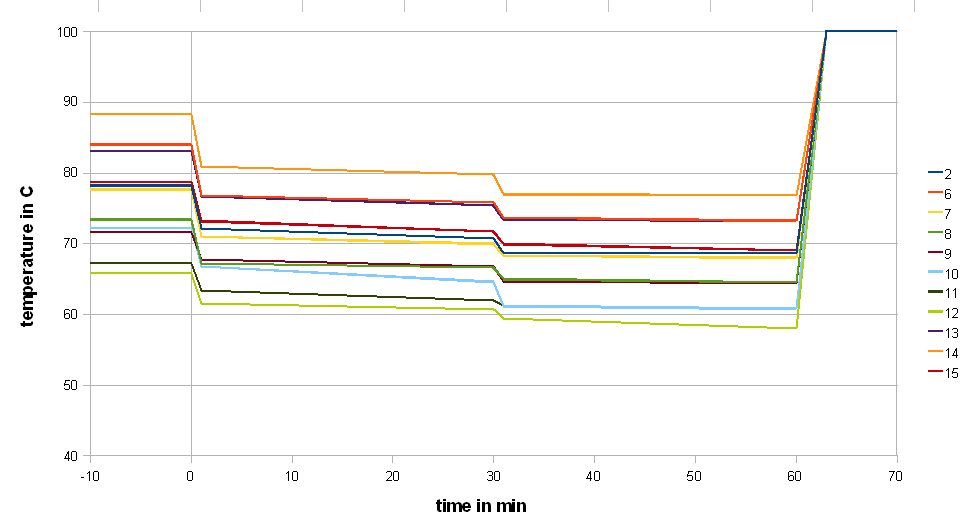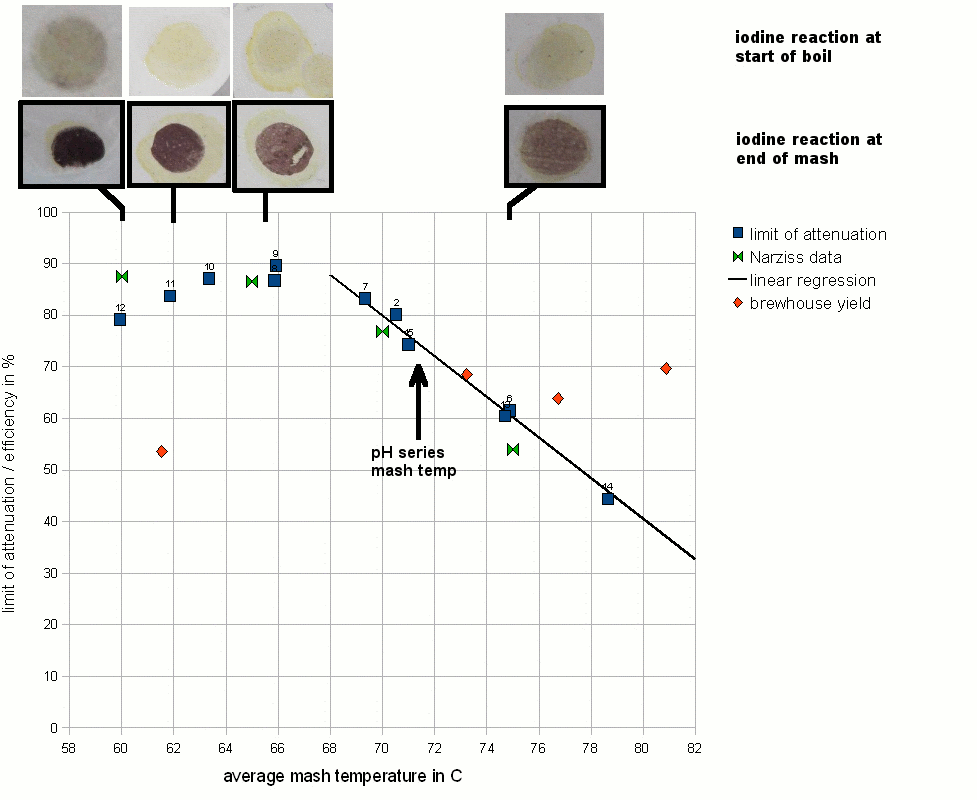Difference between revisions of "Effects of mash parameters on fermentability and efficiency in single infusion mashing"
(→Results and Discussion) |
(→Temperature) |
||
| Line 26: | Line 26: | ||
The first series was conducted with a variation of the mash temperature | The first series was conducted with a variation of the mash temperature | ||
| + | |||
| + | [[Image:Temperature_and_attenuation_mash_profile.gif|frame|Figure 1 - The mash profile for the different mashes that were done for determining the attenuation dependency on the mash temperature]] | ||
[[Image:Temperature_and_attenuation.gif]] | [[Image:Temperature_and_attenuation.gif]] | ||
Revision as of 02:05, 4 June 2008
It is commonly known that there are many factors that affect the fermentability (limit of attenuation) of brewing wort. The series of experiments conducted here are aimed at understanding not only the qualitative impact but also quantify the changes of fermentability depending on the parameters that were considered for evaluation.
In Understanding Attenuation it is mentioned that final attenuation of a beer mainly depends on 2 factors: limit of attenuation and the yeast's ability to come close to that limit of attenuation. The limit of attenuation is only affected by mashing and the Fast Ferment Test has been introduced to determine it. For simplicity sake, these experiments only focus on single infusion mashes and explore the affects of the following mash parameters:
- saccrification rest temperature: This is the first factor that comes to mind for all grain brewers. For a single step saccrification rest, the mash temperature has a great affect on the fermentability of the resulting wort. The lower the temperature (within a given range of course) the longer the beta-amylase will be able to work and produce maltose. See The Theory of Mashing.
- water to grist ratio: the enzymatic activity of the amylases is affected by the thickness of the mash. Thinner mashes enhance the maltose production and therefore increase the fermentability. See The Theory of Mashing.
- grain bill composition (base malt): mashes with high diastatic power (Pilsner, Pale) will produce more fermentable worts since they contain a lager amount of beta-amylase which can produce more maltose than mashes with lower diastatic power (Munich or large amounts of unmalted grains) assuming the same saccrification rest temperature.
- mash pH: the beta and alpha amylase enzymes have different optimal pH ranges (beta amylase : 5.0 - 5.5 pH; alpha amylase : 5.3 - 5.8 [Palmer 2006]) and therefore the mash pH can affect the activity balance between these enzymes. Though the effect is only marginal. See The Theory of Mashing.
- grind: larger grits of endosperm make it harder for the mash water to fully hydrate them and make the starches accessible to the enzymes. The as a result lots of starch is released later when the beta amylase activity is already diminished. The result of a coarser grind is a lower limit of attenuation. See The Theory of Mashing.
Materials and Methods
All experiments were conducted at a relatively small scale with minimal overhead. The strike water was heated in the micro wave. The time spent in the micro wave was noted for each experiment and provided a guidance for future experiments. After a number of experiments it was possible to come close to a desired mash temp by estimating the necessary heating time. The water was then added to a small steel thermos bottle where it was left for about 5 min to settle. A Styrofoam stopper was fitted for the bottle which also held an alcohol filled thermoter. The tip of the thermometer reached into the water/mash and it was possible to read its temperature without opening the bottle. The settled temperature was recorded and the milled grain was sirred into the water. 5 min into the mash the mash temperature was recorded. It was also recorded 30 min into the mash. Then the mash was stirred and its temperature recorded 5 min later. The last time the temperature was recorded was at the end of the mash.
Once the 60 min mash was complete a sample of the wort was tested for starch conversion with iodine on chalk. This was only done for select mashes. The mash was then lautered through a stainer set over a pot. In all cases it took less than 2 min to bring the first runnings to a boil. In the meantime sparge water was heated in the microwave and the grain was well mixed with the water before it was lautered again through the strainer. This sparging technique resembled a batch sparge.
After the wort was boiled for 15 min it was strained though a paper towel set in a funnel. The funnel was placed into a clean 12 oz bottle. Initial experiments sanitzed the bottles and the funnel in boiling water. But that became to cumbersome and due to the high pitching rate that was to follow the affect that infections could have on the attenuation measurement was deemed insignificant. The wort in the bottle was then topped of with reverse osmosis water when necessary. Initial experiments didn't care about the precise amount of wort in the bottle unless there would be enough for 2 hydrometer readings, but later it was decided to keep the volume the same (top off when necessary) to get a measure of the mash efficiency along with the attenuation.
After capping the bottle with aluminum foil, the wort was left to cool at room temperature. Once cooled the original extract was measured with a hydometer (range 0 - 40 Plato) and then pitched with 1/2 teaspoon of Fleishmann instant bread yeast. Dry bread yeast was chosen for its low cost. In previous fast ferment tests, where it fermented along side other yeasts, it has been determined that it attenuates similar to other ale yeasts.
The samples were fermented at about 20 C (70 F) for 4-6 days. They were occasionally shaken to rouse the yeast. After the 4-6 days of fermentation the yeast started to settle and no visible signs of fermentation were left. The final extract (=final gravity) of the sample was measured with another hydrometer (range 0.990 - 1.020). Both hydrometers were calibrated with various sugar solutions (20, 10, 5, 2.5 and 0 Plato) and the readings were also corrected for temperature.
Results and Discussion
Temperature
The first series was conducted with a variation of the mash temperature



